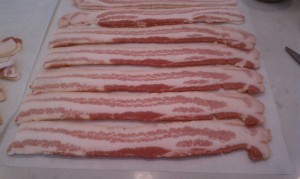 Bacon, bacon, B-A-C-O-N! There are some foodies who consider bacon to be the Food of the God’s. While Paula Deen has her well-known belief of “you can never have enough butter” (and I do SO agree), there are many bacon fans out there that would rather have to listen to a Milli Vanilli Greatest Hits Marathon than do without their bacon. I think we’d encourage a lot more people to carry firearms if we were ever able to convince bacon lovers that zombies might take their precious salted pork someday. “Zombies after my bacon?! Now them's fightin’ words!”
Bacon, bacon, B-A-C-O-N! There are some foodies who consider bacon to be the Food of the God’s. While Paula Deen has her well-known belief of “you can never have enough butter” (and I do SO agree), there are many bacon fans out there that would rather have to listen to a Milli Vanilli Greatest Hits Marathon than do without their bacon. I think we’d encourage a lot more people to carry firearms if we were ever able to convince bacon lovers that zombies might take their precious salted pork someday. “Zombies after my bacon?! Now them's fightin’ words!”
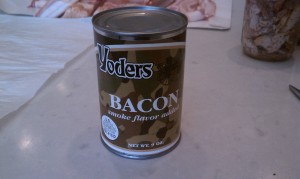 NOTHING else tastes like bacon any better than BACON.
NOTHING else tastes like bacon any better than BACON.
It just can’t be replicated with a pill, hypnosis, and definitely not TVP! I suspect that this is why groceries chains are claiming that the amount of bacon sales has not reduced in spite of a 15.6 percent increase from December of last year to the end of January 2012. $4.65 a pound! Ouch! And with the prices of fuel, corn, as well as so many other things that influence the price of this scrumptious pork product, we’re not likely to see it go under $4.00 a pound again any time soon. (see: Bureau of Labor Statistics - Average Retail Foods Prices). I suppose that makes sense when you consider that bacon slides its way into every meal of the day, and if you’ve ever tried the chocolate covered bacon, it will definitely sizzle its way into your snack time of day. But after seeing 9 oz can of canned bacon sell for $17.99 one day, I knew that I had to find an alternative to feed the salty hunger cravings AND I had to stick with my criteria of getting it at an affordable price and stocking up without having to worry about freezer space.
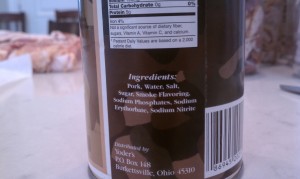 I always say that if the store can do it, then so can I. And after having such great success in canning nearly every other meat imaginable, I certainly didn’t want to miss out on a successful home canning method. So I studied and played and experimented—a lot—because I found a lot of reports of failed attempts as well as some less than fabulous attempts. I also saw a lot of people doing it the hard way—or worse, the expensive way.
I always say that if the store can do it, then so can I. And after having such great success in canning nearly every other meat imaginable, I certainly didn’t want to miss out on a successful home canning method. So I studied and played and experimented—a lot—because I found a lot of reports of failed attempts as well as some less than fabulous attempts. I also saw a lot of people doing it the hard way—or worse, the expensive way.
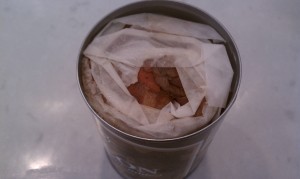 There are a lot of various complaints regarding home-canned bacon. And, if you know foodies, you know that anything other than “Wow! That tastes great!” just won’t do! Issues such as the canned bacon crumbling when cooked, tasting odd, time consuming, hard to get out of the jar afterwards, waste of good meat fat, etc., etc. were just a few of the concerns I wanted to address. So here you go; here’s my best pork leg forward.
There are a lot of various complaints regarding home-canned bacon. And, if you know foodies, you know that anything other than “Wow! That tastes great!” just won’t do! Issues such as the canned bacon crumbling when cooked, tasting odd, time consuming, hard to get out of the jar afterwards, waste of good meat fat, etc., etc. were just a few of the concerns I wanted to address. So here you go; here’s my best pork leg forward.
Satisfy your family's craving for bacon by making your own Home-canned bacon! It's the best!
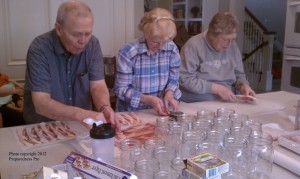 First of all, how you can your bacon is determined by what you want it ultimately to look like when you serve it. If you just want bacon in order to flavor beans, quiches, scrambled eggs, or something in which you don’t need full-crispy strips, then all you have to do is can bacon the way you do any other meat. Stuff it in the jar raw up to the screw rings, wipe off the rim, place a clean flat lid on top, then the jar ring on top, and then process it for 75 minutes at 10 pounds of pressure for pint jars (which are my preferred sizes for such recipes) and 90 minutes for quart jars at the same pressure—though high elevation may require 15 pounds of pressure. When in doubt, read your manufacturer’s directions. This method will cook your bacon thoroughly and will enable it to easily last on your cool, dark shelves for 10 years. Yes, I said 10 years. That grin on your face is perfectly permissible. When you’re ready to dig in to this bacon, just pour all of the contents into your beans, or dump the contents into a frying pan and sizzle them up on a medium-high heat. Drain the fat and save it in a covered glass jar for future cooking oil needs. (That’s the good kind of fat for the body—much better than any hydrogenated fats.)
First of all, how you can your bacon is determined by what you want it ultimately to look like when you serve it. If you just want bacon in order to flavor beans, quiches, scrambled eggs, or something in which you don’t need full-crispy strips, then all you have to do is can bacon the way you do any other meat. Stuff it in the jar raw up to the screw rings, wipe off the rim, place a clean flat lid on top, then the jar ring on top, and then process it for 75 minutes at 10 pounds of pressure for pint jars (which are my preferred sizes for such recipes) and 90 minutes for quart jars at the same pressure—though high elevation may require 15 pounds of pressure. When in doubt, read your manufacturer’s directions. This method will cook your bacon thoroughly and will enable it to easily last on your cool, dark shelves for 10 years. Yes, I said 10 years. That grin on your face is perfectly permissible. When you’re ready to dig in to this bacon, just pour all of the contents into your beans, or dump the contents into a frying pan and sizzle them up on a medium-high heat. Drain the fat and save it in a covered glass jar for future cooking oil needs. (That’s the good kind of fat for the body—much better than any hydrogenated fats.)
Here’s a quick bacon hint
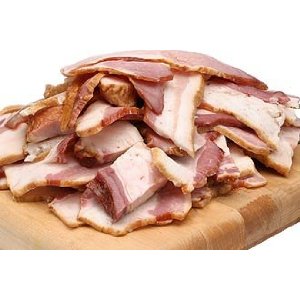 You can save a lot of money on buying bacon that you don’t need to end up in a particular shape. A lot of meat counters in grocery stores will set aside the bacon bits, ends, and pieces. Sometimes as they are cutting it, the strips are too thick, too thin, too small, or just plain falling apart or in pieces once the good stuff’s cut. But for you, this is perfectly wonderful bacon to have on hand for anything that doesn't require crispy strips. Making some phone calls to ANY of your stores or meat manufacturers would be a great way to get your hands on some yummy bacon for much less than the strips.
You can save a lot of money on buying bacon that you don’t need to end up in a particular shape. A lot of meat counters in grocery stores will set aside the bacon bits, ends, and pieces. Sometimes as they are cutting it, the strips are too thick, too thin, too small, or just plain falling apart or in pieces once the good stuff’s cut. But for you, this is perfectly wonderful bacon to have on hand for anything that doesn't require crispy strips. Making some phone calls to ANY of your stores or meat manufacturers would be a great way to get your hands on some yummy bacon for much less than the strips.
Now if it’s crispy bacon strips along side your waffles or on a tasty bacon, sprouts, and tomato sandwich that you want, well, that’s when you pull out the wide-mouth quart jars stuffed with canned bacon. Obviously the goal is to have bacon be shelf-stable for 10 years AND be able to cook up as sizzling strips. So here’s what you will need:
- 1 wide-mouthed quart size mason jar for approximately every pound of bacon you want to can with appropriate lids.
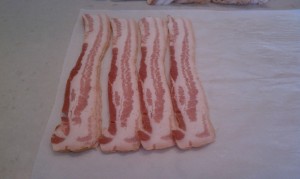 All the smoked bacon you care to can, (preferably thick cut, but if not, no problem. We’ve got a fix for that.)
All the smoked bacon you care to can, (preferably thick cut, but if not, no problem. We’ve got a fix for that.)
- Metal against Metal pressure canner. (All-American is my canner of choice, and yes, I can use it on my flat top stove, or my butane cook stove, or even an open fire if need be.)
- Parchment Paper: The single sheets work fine if your bacon is shorter—or you could always cut the bacon to the right length and use the pieces to stuff a bacon scraps jar. But if you’re bacon is longer, like that which comes from Zaycon Foods, you’ll need to use the rolls of parchment paper. You COULD use masking paper instead, which you can get at the hardware store for cheap. But I’m only interested in using food-grade paper. It doesn’t matter if the paper is white or brown.
- Scissors for cutting the bacon if necessary and for cutting the parchment paper to size
- A heavy, flat rock or brick: this is necessary when canning quart jars. The jars have quite a bit of air in them and thus they tend to float when immersed in just enough water to cover their lids. Yup, I actually have a canning rock now that I can bacon. *grin* (You could stack more jars on top and try that, but this just depends on how many your canner will hold.)
- Paper towels: you’ll use these to clean off the rims of the jars prior to putting the lids on them.
- 1/4 to 1/2 cup of vinegar
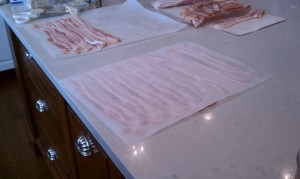 Take a single sheet of parchment paper, (about 12 x 15 inches); the rolled parchment paper will be wider than that, but no problem.
Take a single sheet of parchment paper, (about 12 x 15 inches); the rolled parchment paper will be wider than that, but no problem.
Lay it flay on a clean smooth surface.
Lay 8 strips of thick cut bacon down on the paper parallel with the short side of the paper side by side each other, no overlapping necessary. If you are using non-thick bacon, then place two strips of bacon on top of each other, exactly aligned as much as possible; repeat that 8 times across the paper as you would the single strips of thick bacon. This little trick will help you to have nice strips of bacon rather than bacon that falls apart.
As your placing the bacon on the sheet, begin to the far left. You’ll have a little bit of space left over on the pre-cut sheets but if you’re using parchment rolls, then cut your sheets so that you do have about 4 inches excess on the right side.
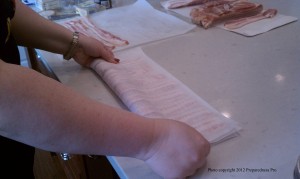 Once you’ve filled your sheet of bacon place another sheet of parchment paper on top of the bacon, smoothing it out flat and matching it end to end. I see many people miss this important step, but don’t skimp. Do it so that you get the final product that you’ll want when you get to open your jar full of this yummy stuff! Other than doubling the bacon to purposely create thicker pieces by double layering, you don’t want the bacon rolled on top of itself.
Once you’ve filled your sheet of bacon place another sheet of parchment paper on top of the bacon, smoothing it out flat and matching it end to end. I see many people miss this important step, but don’t skimp. Do it so that you get the final product that you’ll want when you get to open your jar full of this yummy stuff! Other than doubling the bacon to purposely create thicker pieces by double layering, you don’t want the bacon rolled on top of itself.
Fold the three layers in half lengthwise, directly in half. If you have paper up at the top that’s longer than the bacon, fold the excess paper in, towards you, and smooth the fold.
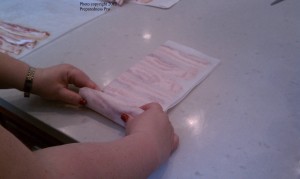 Now tightly roll your multi-layered stack lengthwise (like a burrito), taking care to keep the loose edge of the parchment paper folded down as you go along. Again, you’ll want this to be nice and tight. As you get to the end of your length, the slick bacon may begin to get squeezed out a bit, but it shouldn’t be even as much as the width of a strip of bacon.
Now tightly roll your multi-layered stack lengthwise (like a burrito), taking care to keep the loose edge of the parchment paper folded down as you go along. Again, you’ll want this to be nice and tight. As you get to the end of your length, the slick bacon may begin to get squeezed out a bit, but it shouldn’t be even as much as the width of a strip of bacon.
Now, if you have some bacon exposed on the far end of your roll, then cut a piece of parchment wide and long enough to wrap outside of your roll of bacon to create a smooth exterior, covering bacon that may have slipped out during your rolling.
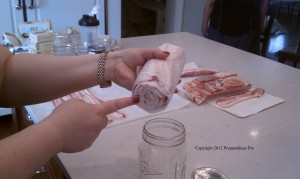 Now, place the roll with the smooth fold edge facing UP. This is so that you get as much of your bacon fat at the bottom of the jar while it's being pressure canned. The grease is so much easier to use later when you do it this way. You may end up twisting and squeezing just a bit, but I’ve done this enough times that 8 pieces of bacon should fit perfectly in your wide-mouthed quart jars. If you attempt to do this with regular mouth jars, you’ll end up wasting a LOT of space in the jar and it will take you many more to get the job done. DO NOT ADD WATER to your jars.
Now, place the roll with the smooth fold edge facing UP. This is so that you get as much of your bacon fat at the bottom of the jar while it's being pressure canned. The grease is so much easier to use later when you do it this way. You may end up twisting and squeezing just a bit, but I’ve done this enough times that 8 pieces of bacon should fit perfectly in your wide-mouthed quart jars. If you attempt to do this with regular mouth jars, you’ll end up wasting a LOT of space in the jar and it will take you many more to get the job done. DO NOT ADD WATER to your jars.
Wipe the rims of your jars with a clean paper towel to ensure there’s no residue on it. Place the flat lid on the jar and then place the jar ring on, tightening it gently—only “fingertip tight”—as it’s called in the canning world.
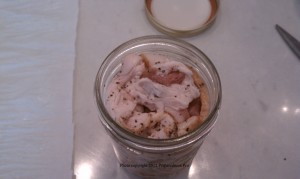 Place the metal rack/liner that comes with your pressure canner in the bottom of the pan. (It will help prevent your jars from cracking and breaking during the pressure canning process.) Then place the number of quart jars in the pressure canner that fit and add 2 to 3 inches of water to the bottom of the pressure canner.(NOTE: this is my own personal preference. You do not need to cover the jars with water. 2 to 3 inches is sufficient. Your manufacturer guidelines will tell you how much water you need for your canner) Add ¼ to ½ cup of white vinegar to the water. This will prevent the outside of your jars from getting corroded with calcium from the water and makes your jars nice and clean. Cover them with the second metal rack that comes with your pressure canner. Place your rock or brick on top of it to hold the jars in place during the pressure cooking process. This will ensure that the entire jar's contents reach the pressure and heat necessary to be safely cooked and stored.
Place the metal rack/liner that comes with your pressure canner in the bottom of the pan. (It will help prevent your jars from cracking and breaking during the pressure canning process.) Then place the number of quart jars in the pressure canner that fit and add 2 to 3 inches of water to the bottom of the pressure canner.(NOTE: this is my own personal preference. You do not need to cover the jars with water. 2 to 3 inches is sufficient. Your manufacturer guidelines will tell you how much water you need for your canner) Add ¼ to ½ cup of white vinegar to the water. This will prevent the outside of your jars from getting corroded with calcium from the water and makes your jars nice and clean. Cover them with the second metal rack that comes with your pressure canner. Place your rock or brick on top of it to hold the jars in place during the pressure cooking process. This will ensure that the entire jar's contents reach the pressure and heat necessary to be safely cooked and stored.
 Place the lid on the canner and “baton down the hatches”, sealing it up; but do NOT put the round weight on it yet. Bring your burner to high heat and wait until you have a hearty, steady stream of steam coming out of the valve. Allow this steam to continue for 5-10 minutes based on manufacturer's directions. This is purging the air from your canner. Once the steam is steadily escaping, place your weight, at the 10 pound hole/indicator, on the valve. Now follow your manufacturer’s instructions in terms of how what to be mindful of during the canning process. My instructions state that the weight should only rattle once every 3 to 5 minutes. I adjust the heat downward gradually in order to maintain that. Your stove will vary, but mine usually ends up on the "2" setting or Med-Low, by the time I've got the perfect pressure. I'm constantly checking my gauge to make sure that I am maintaining the pressure at or above the 10 pounds.
Place the lid on the canner and “baton down the hatches”, sealing it up; but do NOT put the round weight on it yet. Bring your burner to high heat and wait until you have a hearty, steady stream of steam coming out of the valve. Allow this steam to continue for 5-10 minutes based on manufacturer's directions. This is purging the air from your canner. Once the steam is steadily escaping, place your weight, at the 10 pound hole/indicator, on the valve. Now follow your manufacturer’s instructions in terms of how what to be mindful of during the canning process. My instructions state that the weight should only rattle once every 3 to 5 minutes. I adjust the heat downward gradually in order to maintain that. Your stove will vary, but mine usually ends up on the "2" setting or Med-Low, by the time I've got the perfect pressure. I'm constantly checking my gauge to make sure that I am maintaining the pressure at or above the 10 pounds.
IMPORTANT NOTE: You do not start counting your minutes of canning time UNTIL your canner has come up to the proper pressure.
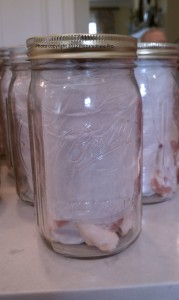 Once you’re finished pressure canning turn off the heat, carefully remove the weight from the valve (I use a towel or pot holder), and wait for the pressure to complete drop. (YES! You can do this, unless of course you want to cook your meat a little longer and let it shred to pieces or you want to wait all day for the pressure to drop naturally. A canner is much like a pressure cooker. Quick Release is an acceptable option for pressure release.)
Once you’re finished pressure canning turn off the heat, carefully remove the weight from the valve (I use a towel or pot holder), and wait for the pressure to complete drop. (YES! You can do this, unless of course you want to cook your meat a little longer and let it shred to pieces or you want to wait all day for the pressure to drop naturally. A canner is much like a pressure cooker. Quick Release is an acceptable option for pressure release.)
Once the steam has fully escaped, then carefully open your canner with the lid facing away from you as more steam will escape. With a jar lifter, carefully lift the jars out of the canner and rest them on your counter (cover counter appropriately to prevent burning or melting of the counter material, such as with a dish towel.) Allow the jars to cool completely for 24 hours. Within the first 30 minutes of cooling you will begin to hear the lids popping. This is how you know they are sealing. When cooled, you will need to clean the outside of the jars with warm soapy water as grease will have escaped into the water during the pressurizing process.
After the first 24 hours, gently re-tighten the lid rings to fingertip tight. Wash the exterior of the jars as necessary to remove any fat or other debris. Then keep the jars out for another 24 hours just to be certain that they have all sealed.
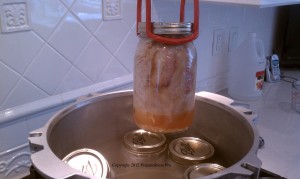 You can test for sealing by pressing your finger in the center of the flat lid. If it “pops” up and down as you press it, it isn’t sealed and you’ll need to replace the flat lid, or just eat the bacon sooner, rather than later. Store in a cool, dark place. Your bacon is completely cooked and could be consumed directly from the jar.
You can test for sealing by pressing your finger in the center of the flat lid. If it “pops” up and down as you press it, it isn’t sealed and you’ll need to replace the flat lid, or just eat the bacon sooner, rather than later. Store in a cool, dark place. Your bacon is completely cooked and could be consumed directly from the jar.
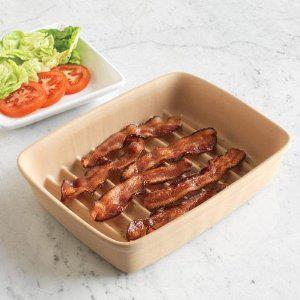 When it’s time for you to enjoy your crispy bacon strips my best suggestion to give you is to BAKE the bacon on a piece of stoneware at 375 for about 15 or 20 minutes. You can fry them in the skillet, but due to the pre-cooking the bacon’s already endured it’s likely to fall apart a bit for you. However if you used thick bacon strips or double-stacked the two bacon strips, you shouldn’t have this problem. Also, frying them in the skillet at medium to medium high heat will also ensure your strips turn out beautiful.
When it’s time for you to enjoy your crispy bacon strips my best suggestion to give you is to BAKE the bacon on a piece of stoneware at 375 for about 15 or 20 minutes. You can fry them in the skillet, but due to the pre-cooking the bacon’s already endured it’s likely to fall apart a bit for you. However if you used thick bacon strips or double-stacked the two bacon strips, you shouldn’t have this problem. Also, frying them in the skillet at medium to medium high heat will also ensure your strips turn out beautiful.
One last little tip. Obviously you’ll want to save the grease that you’re apt to have at the bottom of the jars. But, if you save the parchment paper that you used to can the bacon as well, you’ve got a little extra tool for the next time you need to grease and flour a pan. Simply take a piece of the parchment and wipe it all over your pan. It’s got plenty of grease attached to it to serve this purpose.
And THAT’S how we do it Preparedness Pro style! Enjoy!
Category:
© 2019 Of COURSE this post is Copyright Protected by Preparedness Pro. All Rights Reserved. NO portion of this article may be reposted, printed, copied, disbursed, etc. without first receiving written permission by the author. This content may be printed for personal use only. (Then again, laws are only as good as the people who keep them.) Preparedness Pro will pursue all violations of these rights just as vigorously as she does any of her other freedoms, liberties, and protections.
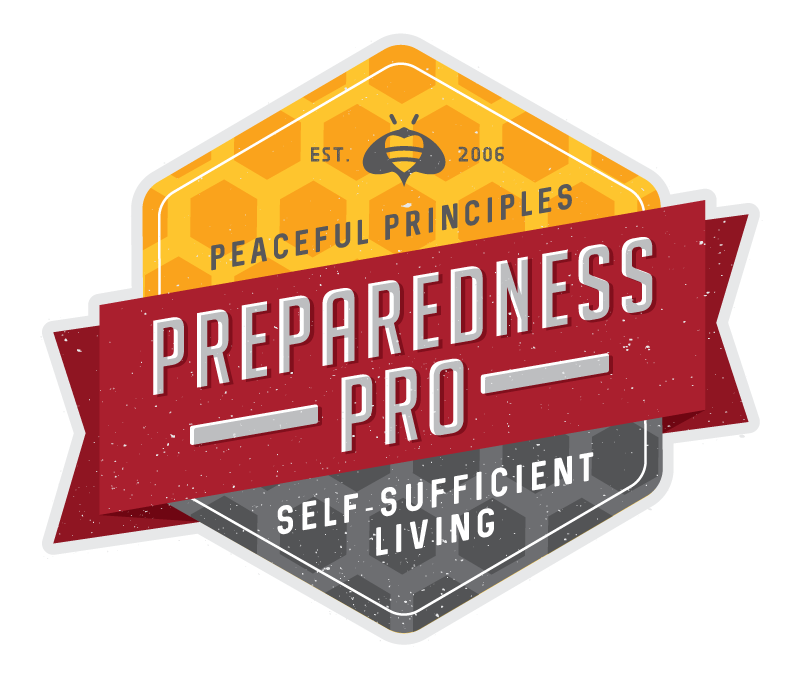

Comments
Once again you inspired me. I did my first 15lbs of bacon lastnight. As I was taking them out of the canner I realized I put the folded side in the bottom of the jar, opposite what you said to do. Darn, that's what happens when you let the hubby interrupt you at a critical step. Oh well, I know it will still taste great just might not get to use as much of the bacon grease. Thanks for all your tips. I always check my canning books, check your site for "easy" steps, then start canning. You always save me time and effort. Like you always say "lazy preparedness." LOVE IT! Any thoughts on alternate ways to use cranberry juice? Got several bottles for free with coupons and I would love to do something besides just drink it. I make jelly with the grape juice I get for free but didn't know what to do with the cranberry juice.
Thanks for your response. I knew that water bathing is not suitable for canning meat. Just had never heard the term " steam canning". Now I know. Very much enjoy your site. Very informative.
Sorry - my question was not very clear. you posted a reply on 4/2/2012 saying "A steam canner is not appropriate for the canning of meats.". What is a steam canner? I have a presto brand pressure canner. Would that be considered a steam canner as the water does not cover the jars?
ah, gotcha. I agree that's not very clear. A Water bath method is not suitable for canning meats, otherwise referred to as a steam canner cause all it really provides is a bit of steam. A pressure canner though is suitable for canning meats and in spite of my preference, no, the water does not need to cover the jars. You can simply follow the manufacturer direction.
I'd love to answer your question but I'm having understanding what it is you're asking me.
I have never heard of metal to metal canners. You mentioned steam not acceptable for canning meat and I'm assuming that covers the rubber seal canners like presto. More info please regarding why. I've just began canning meat according to instructions that came with my canner, as well as the ball book. Please, need more info.
in reply to your question about metal to metal canners...the term applies to canners such as the All-American pressure canner that have a tapered metal to metal surface where the lid contacts the canner. No ruber gaskets to wear out or replace.
I'm not sure why, but it looks like my editor added that picture in spite of all of the other pics in the article. If I had to guess though, I'd say it's Pampered Chef.
Thanks, I'll see if I can find it there... Virginia
Kellene, not exactly a canning question --> I love that ridged bakeware you show and I cannot find one anywhere. What is the brand, if you don't mind sharing? Thanks, Virginia
Nope, you'll need to pressure can it since it's a protein and fat. Oven canning is really only viable for dried goods and is not a good method for even that in my opinion.
Kellene,
I am new to your website, so forgive me if this question has already been asked and answered. Can I fry bacon and then oven can it? My plan would be to fry the bacon first, then place it in sterilized jars and place in oven at 180 degrees for about 20 minutes, then seal with sterilized lids and bands. Would this be a safe way to store cooked bacon pieces?
I have bacon grease that I want to keep long term. I want to use small jelly jars if possible instead of pint jars. Would you can them? Is there any advice about time or pressure or another way to preserve the grease? Thank you. I have canned fruit and vegetables for years but have just started learning about meat.
Look at the article I wrote called "Rendering and Preserving Lard" You'll see all the instructions for it.
Hello!!! Thanks so much for your site... forgive the redundancy, but I'm still confused about my brand new presto pressure canner. You would not suggest using this type for meats? OR, did you simply mean you use the metal-to-metal type. I just want to make sure I have the green light from YOU before I begin! Also.. I'm in Herriman, UT... what time/pressure weight would you suggest for the bacon??
Thanks so, so much!
Is it a metal lid against a metal base? If it is, that's fine, though Presto makes me nervous. The integrity of the metal isn't as solid as I'd want it to be for repeated use. Check with your instruction manual for canning pork and use that for canning bacon.
You can cook it first but not to crispy. Cook it until just before it starts getting brown and then can it. But if it's saving cooking time, there's no need. It will have 75 minutes of pressurized cooking time while you're canning it. :-)
Kellene,
I've seen this question asked, but in some different ways, water bath and oven. My question is, can you cook the bacon first, and then pressure can it? Would the time be less, as it is already cooked?
Thanks
Or instead of cooking them for 60 minutes, you can cook them for 15 in a pressure cooker. Yay!
AH! Thanks, Bob for seeing the question that I couldn't see. Now that you answered it, I'm thinking "DUH--why didn't I understand that that is the question he was asking?" From that standpoint I ONLY use metal to metal canners.
Hi Kellene! I did it! I followed your instructions and I have a supply of beautiful canned bacon. I used 36 lbs. of bacon, 6 rolls of parchment paper and I got 36 jars of bacon. I feel like a proud parent! Thank you thank you! I can't wait for my Zaycon chicken to arrive! I'm thinking about seasoning the meat in the jar with soy sauce or italian dressing or adding some fresh basil.hmmmm.
Does that make me a proud grandma? :-)
I have canned the usual beef, chicken, and pork cuts and have branched out and am canning hot dogs, bratwurst, ground italian sausage patties, breakfast sausage patties, and meatloaf made from italian sausage. What I have found is that meat regardless of what kindor format (strips, ground, chunks, etc) is canned for my elevation at 75 minutes for pints and 90 minutes for quarts with 11 pounds of pressure. Canning meat to me is not confusing as the guidelines for canning have a measure of continuity. Thank you for providing well balanced directions that we can study and use to determine if we want and feel comfortable about utilizing any particular canned food.
I just use what the restaurant supply stores have on hand. That way I know I"m getting a good quality and I'm typically getting it for a much better price than the flimsy stuff sold in the grocery stores. I like getting it "pre-cut" in sheets instead of in a roll because the sheets are the perfect width and length for bacon in pint jars. Have at it. I've been living "high on the hog" literally this past week on BLTs with the canned bacon and homemade bread. Yum!
Hi Kellene, First.... I love, love love your web site and all the detailed info. I am a newbie to pressure canning in as much that I don't even have a canner yet! Being on a limited budget, yet with health and safety of the utmost importance, I am driven to buy the best quality the 1st time around! Within the next couple of weeks I will be purchasing an All American pressure canner! ( All in due thanks to you! ) Can hardly wait! My main priority right now is canning every type of meat I can! I can't even begin to tell you how relieved I was to know that bacon can be canned as well... For me it's NOT "comfort food", it's a must have staple! :) Yes I love my bacon, so it is first on my list to can! :) A question I do have is in regards to the parchment paper... I have seen several brands on the market, but are there different "grades/mills or brand" that would be better suited for canning bacon?
Your bacon will fall apart and no longer remain in strips without the parchment paper. It will still taste fine, but not be usable as bacon strips. Enjoyment will still be fabulous!
Why does the parchment paper need to cover all the bacon? If I accidently didn't see that part, and when I had some extra room, but ran out of parchement paper, so I stuck some extra slices on the outside of the paper, will that damage the meat? Or is it just a sticking to the jar issue? Also, I understand fully, why you copyright your stuff, and am eagerly awaiting your book...This is a long process, and I want to try it, but if it works, I want to try it again...I wish there were a way, to just charge us a little, to print it out, so we can do it again. Kinda like the songs, if you only like one on the album. ;P Just an idea. ;) Thanks for all your time! THis must have taken you quite a bit of effort! I'm making a batch for my 90 yr old dad, who is a prepper, for his birthday! Thanks!
The parchment paper is so
The parchment paper is so that your bacon doesn't get cooked sticking to itself. That's all. It's not the end of the world. It's just an aesthetics and functionality thing.
So jealous!!!
Yes, you can use the unsmoked or uncured bacon. You may get a different end texture, but if you're just using it for dishes, casseroles, soups, etc. that won't be a problem. You can still fry up the strips too, but what I'd suggest is to par-bake them in the oven first for about 10 minutes and then can them so that they hold their shape.
Just found your web site and I love it. We raise our own pigs and our bacon is packaged fresh and then frozen. Can I use the frsh bacon to can even though it is not smoked or cured?
First: I love that I found your site. I am a foody too and can't live without bacon.
I almost bought a can of bacon tonight and I am so happy that I can do this myself.
Second: I can't live without butter either.... Help!!! I have canned vegetables, meat a, fruits and dry goods but I know butter can be done and I am clueless!
The third is for your readers. Do yourself a favor and buy the All American canner. It is cast into a solid piece and is the best canner on the market. I researched canners for 3 months before purchasing mine and have canned over 1,000 jars a year with no problems.
I hope you get your book done sooner than later!
Just put "canning butter" in the search bar on this blog and you'll find instructions for that.
I am new"er" to canning. I had a perfect resource and chose not to pay as much attention as I should. I just purchased a new all american pressure canner that I am SOOOOO excited to get using. Im super excited about canning bacon. I saw about Zaycon foods and canning chicken and cant wait until they sell it again!! So, here is my question about canning the bacon. I probably missed it in the instructions or just dont know what Im looking for. How long, after the steam and I put the weight on, do I leave the heat on? Thanks!!
your heat has to stay on so that you maintain the pressure throughout the entire pressure canning process.
how long do I can for though? I think I understand everything but that part. Once I have the steam and put the weight on how long do I leave it? I just re-read what I posted and it makes no sense, so please forgive me :)
That is going to be based on your manufacturer's instruction booklet. Since it's an All American I believe it would say 90 minutes at 12.5 pounds of pressure or 15 pounds if you in high altitude area.
Thank you!!
kellene...i never ever have heard of canning bacon let alone doing it like this....i will be doing this....thank you.....i do have to buy a new pressure canner ...i have one like you have but i don't trust it to get to the pressure that i need....im on the hunt for a dial gauge so i can see the amount of pressure......
Kelleen -
Kelleen -
Hate to be [edited for graphic language], but what you are recommending is food science untested and potentially a problem.
Just because big industrial food flash cans bacon doesn't mean it is safe for the home canner.
With all that paper how are you so sure that the core temperature of the jar has reached 240F for the proper amount of processing time for a 100% bacteria kill?
The extra layers of rolled paper surrounding the bacon may act as a cushion and insulate the inner core of the jar from the heat. The fat present in the bacon in theory can insulate the spores of clostridium botulinum and the presence of heat may actually begin to activate dormant spores which will soon be in an anaerobic, moist environment – an airtight stored canning jar – and begin to produce toxin.Hopefully people or are doing this are reheating the bacon to 240F for at least 10 minutes.
There are good food science reasons why canning bacon, butter and milk is never a good idea.
Yes, I've read it all and
Yes, I've read it all and heard it all before. I'm completely comfortable with my methods.
Folks who advocate NOT canning such items are obviously unfamiliar with the DECADES of experience and methods that generations before us utilized--and with much less reliable technology and equipment.
I believe that due to the rampant possibilities of food borne illnesses, EVERY can food should be sufficiently heated. However, the 240 degrees that you suggest is woefully excessive since an internal temperature of 85 degrees for 5 minutes is all that's necessary to sufficiently kill the clostridium botulinum. (you can look that up on any CDC site.)
Did you know that the CDC discourages people eating baked potatoes in foil too and yet all kinds of restaurants safely use this practice.
IF I was canning all of this is the backwoods or in a barn, I would perhaps give more merit to your scenario, but there are a bundle of redundant safety measures taken during the canning process with today's process, including working in a clean kitchen, with clean hands. And by the way, the bacteria you refer to originates in the soil. There's NO soil or contact with soil when I'm working in my kitchen. It's kept top notch clean as everyone's should.
Somewhere I saw a post on
Somewhere I saw a post on canning bacon that has been chopped into about 1" pieces. That's how I want to can mine instead of the strips with the parchment paper. BUT I have no idea where I saw that recipe or even how it was done. Have you ever canned it like that or could you help me out? THANKS BUNCHES!!
you could certaninly dry can
Do you have any articles on
Do you have any articles on pressure canning on a flat top stove? I've read that's a no no, and I have a glass topped range. I'd love to do it! Thanks!!
The issue doesn't merit an